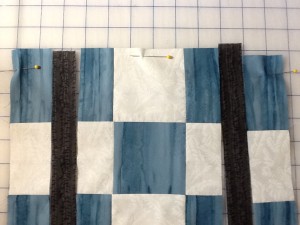Tips for Making the 9-Patch Plaid Block
At the Block Lotto, perfectly made blocks are a GOAL, but NOT a requirement. It is also a place to try new things, practice and improve techniques. With that in mind, a couple of people have shared tips for making this month’s 9-Patch Plaid block and I thought to share them in a post of their own, as a place to share other problems/tips that come up in June.
Keeping 9-Patch Seams Aligned
During the sneak peek, Karen B had this tip for ensuring that the intersecting seams are aligned when you are inserting the strips to make perfectly aligned seams in your blocks.
After adding 1 black strip to a “9P portion” and going to add the next “9P portion, mark on the strip with a chalk pencil where the 9P seam comes to the strip and pin-match that to the 2nd 9P portion before stitching. Use this technique when one is sewing the long strip to a row of blocks that have sashing between them when assembling a quilt top.Karen thought that it was too easy for the graphics to look “off” if she didn’t pin-match the sections. She said, “Just slapping the pieces to the black strip did not give me a good block.”Some folks might not go to the trouble to pin-match the joining areas as maybe have always used cornerstones or don’t realize how even an itty-bitty place that is off when using highly contrasting colors such as white and the blue can look glaring, especially since those strips are so narrow …. small units tend to show up mismatches more than large units.
Like Karen, I also pinned my blocks at those intersections to keep them from shifting when I was sewing the second seam of the inserted strip, though I didn’t mark them, I eyeballed it by lining up the seams of the top and bottom 9-Patch sections.
Keeping the Pieces in the Right Places
 Barb P sent this photo to show how she uses pins to keep the orientation of the cut-up pieces of the 9-patch straight.
Barb P sent this photo to show how she uses pins to keep the orientation of the cut-up pieces of the 9-patch straight.
If you’ve been around awhile, you know that I am a dyslexic quilter and always looking for ways to make sure I don’t get things flipped the wrong way around when sewing them together. I think this is a good technique to help you keep the pieces in the right place … though I will confess that I personally only made ONE of those cuts at a time, sewed it in place, then made the second cut.
Trouble-Shooting Size Issues
This is another easy block that, because it has a total of 6 seams, can have size issues. Small deviations in your 1/4 inch seams can multiply to create blocks with size issues. If your blocks turn out too small (or too large), I would check these measurements:
- The center square should be exactly 3 inches square.
- The inserted strips should measure exactly 1/2-inch wide.
